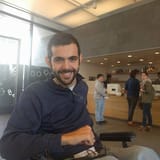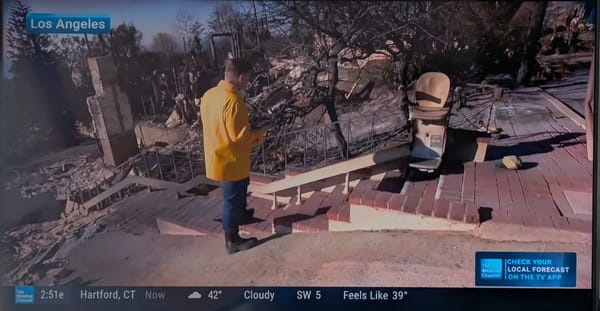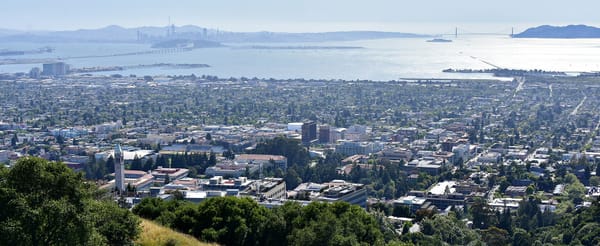Welcome to DisabilitYIMBY!
A newsletter on disability, urbanism, and climate
I’ve been sitting on this newsletter for well over a year and finally ready to get it rolling. Thanks for checking it out — and make sure to subscribe to hear more about disability, urbanism, climate, and whatever else I feel like sharing with the world.
What's in a Name?
For those asking “what’s with that funny newsletter name?,” it’s a combination of “disability” and “YIMBY.” “Disability” might seem like a straightforward term, but the medical and social aspects of disability are broad and complex – there’s a reason there are whole government agencies, advocacy and service-providing nonprofits, fields of academia, etc., both for disability in general and for specific types of disabilities. “YIMBY” stands for “Yes In My BackYard” and represents a movement in favor of more housing, especially in high demand areas, facilitated through new land use and related policies. YIMBY concepts often align with “urbanism” that promotes vibrant urban designs with good transit, amenities near homes, etc., and has even turned into a bit of an identity where housing advocates call themselves “YIMBYs.” YIMBYs often focus on how adding homes can tame housing costs overall; equally important is that good urbanism is a must-have in the fight against climate change.
Motivation and Goals
So, why am I writing this funny-named newsletter? Well, I personally have a disability (a spinal cord injury I obtained in my teens) and have a couple decades of disability-focused activism, community-building and identity under my belt. I’ve also been a climate nerd since about 2005 (thanks Al Gore!) and pursued it through college and grad school and my first job in climate tech. In 2014, I started writing a newsletter on climate justice and the disability community, and through some fortunate events became a researcher and policy specialist at the World Institute on Disability, where some of my work touched on the topic he s to be covered in this newsletter (e.g., the intersection of land use, transportation, climate, and disability). I left WID for private consulting in 2020 and have been involved in a mix of disability and climate work, while becoming more involved in YIMBY activism on the side. Now, I have the itch to write another newsletter, and this seems like as good a theme as any.
The posts here will be written with a desire for disability empowerment, climate resilience, environmental sustainability, and improved quality of life for people with and without disabilities. There will be plenty of thoughts about *waves hand* the world and things in it, plus a smattering of personal notes on independent living, activism, and whatever else comes to mind. I'll strive for accuracy and nuance in a world where, unfortunately, we too often see both well-meaning and bad-faith actors use simpler framing that sounds nice but doesn't withstand scrutiny (and where the bad faith actors push simple propaganda to manipulate the public); and I'll always appreciate good faith feedback and corrections in the comments.
Topics and Themes
For the most part, this newsletter will be based on the following concepts, principles, topics and themes. If these seem like your jam, then please subscribe!
- The very nature of our built environment, from housing to transportation to water management, has a big impact on the natural environment — which in turn lashes back on humans and the built environment in various ways.
- That environmental backlash includes, but is hardly limited to, two of the biggest topics in the public consciousness today: climate change and the consequences of acute pollution including microplastics.
- The US has a tremendous housing shortage and in general much of the housing is in the wrong place and the wrong form compared to what we need for our economy, environment, and climate resilience.
- For the most part, our housing shortage and the layout of our housing stock is the result of bad decisions by the government, influenced by myriad actors at local and national levels.
- The single biggest cause of our housing shortage and our lack of healthy density is the widespread use of city-level zoning and permitting rules shaped to please “Not In My Back Yard” (NIMBY) voters, especially in the wake of the 1950s during the growth and idealization of suburbia.Those zoning rules limit the height and form of what can be built where, making it so it’s difficult-to-impossible to build apartments in most of the urbanized land in America – as a result, we don’t have enough apartments and density in the places people most want to live and have far too much sprawl and car-oriented commutes instead.
- The US also has a bad public transit system and transportation network in general, which is tied to a whole bunch of root causes from auto industry chicanery to Urban Renewal to NIMBYism to the starving of government since Reagan was elected.
- People with disabilities (PWDs) are on average economically and socially disadvantaged compared to able-bodied folks, and there are plenty of accessibility barriers in society. All of those make it so we tend to be in a worse position when it comes to climate change, housing, transportation, employment, and plenty of the other topics I'll cover in this newsletter.
- There are countless aspects of disability, plus countless aspects of climate change and urbanism. So, as an intersectional topic, there's a lot to cover… every connection between one aspect of disability and one aspect of climate or urbanism is worthy of its own post, and then some.
- Some of these intersections are cause for concern. For example, PWDs are often at greater risk of heat stroke and heat exhaustion during climate fueled heat waves, and also tend to live in lower quality housing with worse insulation and HVAC (due to personal finances and a lack of accessible housing on the market).
- However, there's also opportunities for improvement that provide a path forward. For example, the fact that PWDs have lower car ownership means that good density and transit networks (often called “walkability,” but let's just say some PWDs dislike that term…) disproportionately benefit the disability community.
- Building a more sustainable and resilient world will involve long-term investments and policy choices. These can either leave PWDs behind through inadequate design or they can improve inclusion & access alongside sustainability. Of course, we want improvement and not abandonment.
- In general, our collective future should focus on building vibrant, dense, resilient, and accessible cities. Combining universal design and climate-conscious urbanism will improve quality of life, sustainability, climate resilience, and disability rights & inclusion.
- We should also ensure that the social & government infrastructure that supports PWDs — health care systems, social services, transportation networks, the assistive technology ecosystem, disability-inclusive disaster response, and so on — remains appropriately funded and operational, even if/as climate change drives austerity.
I’ll try to get through these points with a mix of concepts, anecdotes, and data. Personally, I’m based in Oakland, CA and lived in Berkeley for about 15 years. Berkeley is the home of the modern disability rights movement and the Bay Area is the birthplace of the YIMBY movement (largely because of our ridiculous housing crunch and entrenched anti-housing policies), so I’ll be using lots of local examples throughout. Given how much activism and urbanism are local issues, the Bay Area won’t reflect everyone’s issues – but it holds a lot of lessons, both good and bad.
Thanks for Joining!
So, that’s the gist of DisabilitYIMBY. Obviously these are important topics to me personally: I've had first-hand frustrations with housing and the built environment and I want the opportunity to live in affordable, accessible and vibrant cities (including by helping transform Oakland to be better). But I'm just one of tens of millions of Americans with disabilities, and well over 1 billion people with disabilities globally – plus, anyone could acquire a disability at a time. The more we can build disability-inclusive, vibrant urban environments, the better for everyone. So let's build a better world together.
– Alex
Thanks for reading DisabilitYIMBY! Subscribe for free to receive new posts and support my work.



